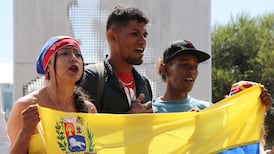Elon Musk’s SpaceX returned four astronauts to Earth to conclude its first regular crew mission to the International Space Station, cementing its status as Nasa’s only commercial partner so far capable of carrying people.
The company's Dragon capsule splashed down in the Gulf of Mexico west of Florida just before 3am local time on Sunday, according to video streamed by Nasa/SpaceX. A SpaceX vessel was to collect the capsule carrying astronauts Michael Hopkins, Shannon Walker, Victor Glover and Soichi Noguchi and return them to shore for medical checks.
The crew's return after more than five months capped Space Exploration Technologies Corp's debut regular mission under a Nasa contract to bring people to the space station – and marked the first time four astronauts visited the facility on a US vehicle since the space shuttle programme ended in 2011. SpaceX carried two astronauts to the station and back last year in a test mission, racing ahead of Nasa's other commercial partner, Boeing Co.
For the latest trip home, the crew undocked the Dragon, which they dubbed Resilience, around 9pm, a time that was selected based on the weather forecast on Earth. During the flight after re-entering the Earth’s atmosphere the capsule faced temperatures of as high as 1,927 degrees.
The coast guard imposed a 3.2km (2-mile) safety zone around the splashdown area. In the return of the August test flight, a weekend boaters sailed up to look at the spacecraft. Nasa said the close proximity was a safety hazard because of the toxic propellants carried by the capsule.
The trip to space was a first for Glover, who also became the first black astronaut assigned to a full rotation on the space station. The so-called Crew-1 mission launched on November 15th with the very same recycled Falcon 9 rocket that lifted Nasa’s current four-astronaut contingent on April 23rd. The Crew-2 mission used a different Dragon capsule, dubbed Endeavour, that is currently docked at the International Space Station.
Crew-1 successful return bolsters SpaceX’s burgeoning role in Nasa’s human spaceflight activities. Nasa also selected SpaceX in April to devise a human lunar-landing system with the company’s futuristic Starship. That award is under protest by other bidders.
Boeing is developing a second spacecraft for Nasa’s commercial crew program, the CST-100 Starliner, which has been beset by delays and a botched test flight last year with no astronauts aboard. Boeing hopes to fly a second Starliner test without people as soon as August. – Bloomberg















